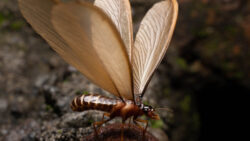If you’re a homeowner in Florida, you’re probably no stranger to the myriad challenges that come with living in this beautiful state. From hurricanes to humidity, the Sunshine State offers its fair share of obstacles for homeowners to navigate. However, one of the most insidious threats that often lurks unseen until it’s too late is that of swarming termites.
What Are Swarming Termites?
Swarming termites, also known as swarmer termites or alates, are reproductive members of termite colonies. These winged insects emerge from their nests during termite swarming season, typically in the spring or early summer, in search of mates and new locations to establish colonies. This phenomenon marks the beginning of a new generation of termites and can be a distressing sight for homeowners.
What Do Termite Swarms Look Like?
Termite swarms can be alarming to witness. Picture a cloud of winged insects, often resembling flying ants, hovering around light sources or windows. These swarms can be large and may occur both indoors and outdoors.
Signs of Swarming Termites
Recognizing the signs of swarming termites is crucial for homeowners. Some common indicators include:
- Winged Insects: The most obvious sign is the presence of winged termites around your property, particularly near light sources.
- Discarded Wings: After mating, swarmer termites shed their wings, leaving behind piles of discarded wings near windows, doors, or other entry points.
- Mud Tubes: Subterranean termites, one of the most common types in Florida, build mud tubes to travel between their nests and food sources. Finding these tubes around your home can indicate termite activity.
- Wood Damage: As termites feed on wood, you may notice hollow-sounding timber or visible damage such as bubbling or peeling paint, sagging floors, or weakened structures.
Risks of Termites
While swarming termites don’t pose significant risks to homeowners, their presence can indicate the presence of an established termite colony nearby. Risks of a nearby termite colony include:
- Structural Damage: Termites can cause extensive damage to wooden structures, compromising the integrity of your home and necessitating costly repairs.
- Financial Loss: Repairing termite damage can be expensive and may not be covered by insurance, depending on your policy.
- Decreased Property Value: Termite infestations can lower the value of your home and make it less attractive to potential buyers.
- Health Concerns: While termites do not pose direct health risks to humans, the presence of swarms and termite activity can cause stress and anxiety for homeowners.
What to Do If You Encounter Swarming Termites
If you encounter swarming termites in or around your home, it’s essential to take prompt action:
- Remain Calm: While it may be unsettling to discover a termite swarm, panicking will not solve the problem.
- Contact a Professional: Reach out to a reputable termite control company for a thorough inspection of your property and professional advice on treatment options.
- Avoid Disturbing the Swarm: Refrain from disturbing or attempting to eliminate the swarm yourself, as this can scatter the termites and make it harder to assess the extent of the infestation.
- Take Preventive Measures: While awaiting professional assistance, you can minimize the risk of further damage by sealing cracks and crevices, reducing moisture levels, and removing potential food sources such as wood debris or mulch from around your home.
Tips for Preventing Termites
Prevention is key when it comes to protecting your home from termites. Here are some tips to help minimize the risk of infestation:
- Schedule Regular Inspections: Have your home inspected for termites annually, especially if you live in an area prone to termite activity.
- Reduce Moisture: Repair leaky pipes, faucets, and roofs to eliminate sources of excess moisture, as termites are attracted to damp environments.
- Maintain Ventilation: Ensure proper ventilation in crawl spaces and attics to prevent moisture buildup.
- Store Wood Properly: Store firewood, lumber, and other wooden materials away from your home’s foundation and off the ground.
- Use Termite-Resistant Materials: When building or renovating, opt for termite-resistant materials such as treated wood or metal framing where possible.
- Create a Barrier: Consider installing physical or chemical barriers, such as termite shields or soil treatments, around the perimeter of your home to deter termites from entering.
In conclusion, swarming termites are not just a nuisance; they pose serious risks to homeowners in Florida. By understanding the signs of termite activity, knowing what to do if you encounter a swarm, and implementing preventive measures, you can protect your home from these destructive pests. Remember, when it comes to termite control, early detection and professional intervention are key to minimizing damage and preserving your peace of mind.



